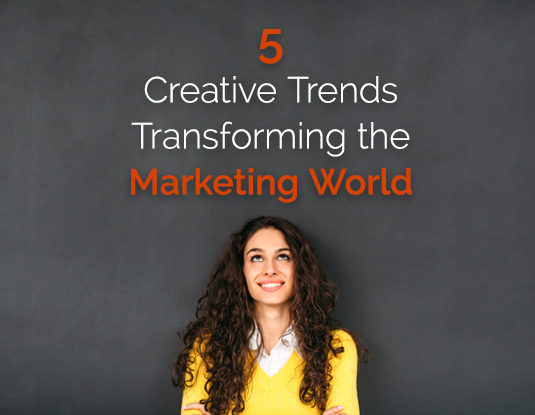deccatalkingpoints@decdesign.com
5 Creative Trends Transforming the Marketing World

The word “transformative” may be as overused as “game-changing,” but it wouldn’t be a reach to use either when describing our current creative renaissance. Previous creative renaissances have been driven by technology, and this one is no different. Contemporary media currently provides so much opportunity for today’s creative marketers and may soon offer even more. Check out these five trends that prove the point.
1. The human body is the latest user interface.
Facial recognition on your phone? A microchip implanted below your thumb? User interface is moving beyond the touchscreen and human anatomy is quickly moving to the forefront of the “quality user experience.” It may sound like the stuff of science fiction, but two separate groups of researchers in Germany are testing technologies that use the human body as an integrated component of the user interface. Many industry innovators also believe that technology will soon become more transparent as the human body becomes the ultimate interface.
2. Popularity is giving way to performance.
Traditionally, brand personality has always dominated consumer passion. Customers have typically sought out brands they can relate to. More and more these days, customers are looking for experiences. This reality calls for a new approach to the top-down creative development process, and calls for experiential creative strategies that optimize individual media channels. For example, one promotion recently allowed users to remotely skip a stone at a lake using a mobile app, leveraging the mobile medium to let users perform during the brand experience. It’s the medium, not the message, that enables such possibilities.
3. Big data can bring forth big ideas.
While on the topic of experiential marketing, we need to mention big data. Big data is almost exclusively used to inform, but it’s human intuition that determines how the data is used. While data might be seen as creatively constraining, it can be utilized to drive creative experiences that audiences connect more personally with. Creative brilliance is essential to bringing brands to life. That brilliance can then be applied to new brand experiences, which big data makes possible.
4. Diversity is the new gateway to trust.
Marketing often promotes diversity as a broad topic. But diversity is now a strategic brand imperative. Why? Because genuine diversity is what now garners customer trust. Diversity makes companies seem more authentic. AJ Hassan, the executive creative director behind the iconic “Like a Girl” campaign, says, “There’s a responsibility to being authentic, and [businesses] must accept nothing less.” In this renaissance, diversity opens the gate to trust, which authentic marketing will walk through. This is done by leveraging creative and technology to expresses genuine human moments.
5. Trust isn’t won with algorithms.
Advertising technology algorithms can’t replace human wisdom, intelligence, and insight. Yet, that human element is rarely integrated into marketing analysis. It’s a gap many feel undermines the trust between consumers and brands. New technologies, however, are helping to overcome that obstacle. Virtual reality and wearable technologies, for instance, give power back to audiences in the form of experiences they trust, because they control them.
The creative strategy model seems to be expanding for the first time in decades. These trends illuminate the reality it’s no longer enough to create unique messages when consumers really want unique experiences. Design and the future of advertising are evolving more and more to focus on how to deliver these experiences.
Based on 5 Transformative Creative Trends In 2017 by Judy Shapiro
